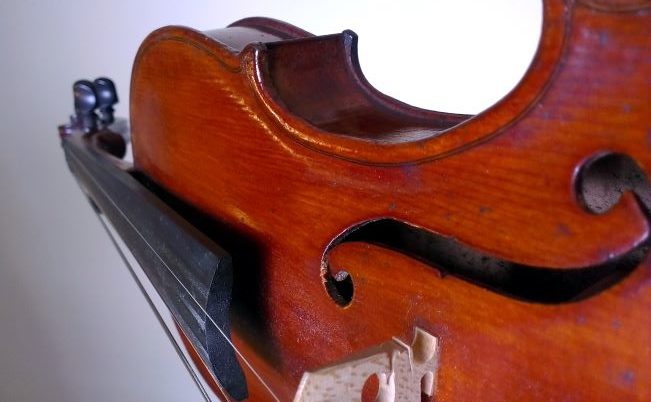Today’s post discusses one area of ongoing research: the relationship between literate and oral cultures of transmission in the 18th century.
Period-specialist music ensembles have for some time now been interested in what David Johnson called the ‘Scots Drawing Room style’, understood to be a hybridisation of indigenous melody with Italianate continuo-bass derived harmonies and playing styles. See David Johnson, Scottish Fiddle Music in the 18th Century (Edinburgh: Donald Press, 1984).
Following his ground-breaking book Music and Society in Lowland Scotland in the Eighteenth Century (1982), Johnson turned to look specifically at the fiddle. The impact of the European late baroque / early classical style, he argued, transformed an indigenous tradition into a new, hybrid ‘Scots Drawing Room Style’. The theme and variation principal found in Scottish ceòl mòr merged with period theme and variation forms, using melodies derived from pibroch repertoire to create variation sonatas. Traditional ceòl mòr, he argued, transferred readily into light fiddle dance tunes, now clearly differentiated by meter and tempi as reels, strathspeys, jigs, etc. Continental European techniques such as scordatura (non-standard tuning of the 4 fiddle strings) were also incorporated into Scottish playing, facilitating brisker tempi as well as more virtuosic playing. This, argued Johnson, created a new species of hybrid art music, one that combined elements of native Scottish and European practice.
Johnson’s ideas have been influential in bagpipe studies as well (see our last post). Attention to the contents of published collections of fiddle music suggests that what we now think of as ‘traditional’ tunes were collected and published by Scottish music entrepreneurs who realised that their “national” repertoire, newly up-cycled with the fashionable Italianate styles, presented them with commercial musical opportunities. Based on the evidence of the music books, this seems to be uncontroversial. However, while Johnson’s findings are true of literate, middle class Scotland and its music making, oral circulation clearly persisted of music in rural contexts outside of this essentially urban culture, and this may have been different in ways that are – by definition – much more difficult to recover.
How is it possible to recover traces of the oral from the material evidence of period-published music? One approach taken in the last two decades has been to apply big-data analysis. Cataloguing projects facilitating ‘big data’ analysis of printed music and manuscripts have attempted to map the historic repertoire and to think about the interaction of print with an elusive oral tradition. Two examples are given below.
- The Scottish Music Index compiled by Charles John Gore, Morag-Anne Elder, and Lynn Morrison, along with an accompanying book The Scottish Fiddle Music Index: the 18th and 19th century Printed Collections (Amaising Publishing House, 1994). The online resources is currently still available although Gore sadly died at the end of 2021, and the site may not be available for much longer. This comprises a title index of fiddle tune collections, cross-referenced to melodic theme-coded listings of ‘Scotland’s original dance tunes and song airs’. The original project drew on a wide range of printed collections from c1700 to c1820, and Gore’s online resource subsequently added later material tracking what Gore calls ‘300 years of tradition’ (‘About this Website’). The ‘theme codes’ use the opening 2 bars (for 4/4 or 2/2) or 4 bars (for 6/8 meters) of each tune with numbers showing ‘intervals going up and down’, numbered 1-7 +octave label for each degree of the home scale. The method may not always disambiguate every instance where a passing note is incidental rather than core to the melodic outline, but delivers pragmatically for a large number of tunes, and the annotated bibliography also provides a helpful map of resources. Gore’s later book, Echoes of a Golden Age: Rediscovering Scotland’s Original Fiddle Music (Highland Music Trust, 2008), can still be sourced and for those new to the field is a short and readable introduction to this endeavour.
- Bass Culture in Scottish Musical Traditions project (2012-2015, AHRC funded). Led by David McGuinness, with Susan Rankin, John Butt (of the University of Glasgow) and Karen McAulay, one of the Performing Arts Librarians at the Royal Conservatoire of Scotland, with various associated doctoral students including Aaron McGregor. The main research output is the Historical Music of Scotland database which collates separately printed Scottish fiddle music before 1850 (with a searchable index for tunes and composers) compiled by McGuinness and McAulay, and McGregor’s catalogue of 27 manuscripts.
The Bass Culture project is evidently focussed on music that combined melodies with continuo bass lines, which is by no means everything from this period, but which represents the kind of Italianate hybrid music discussed by David Johnson. Taken as a whole, the project findings indicate that the bass lines in published editions show how the harmonies associated with these melodies changed through the course of the eighteenth century because of the implications of the bass accompaniment. However, while mid-century collections often demonstrated harmonies and styles closer to the Italian models, towards the later end of the century collections begin to show a lighter-touch approach to bass harmonies combined with a stronger sense of rhythmic impetus which perhaps suggests the ‘Drawing Room Style’ responding to contemporary dance practice. (See McAulay, K, ‘Following the Bass: A New Digitisation Project for Scottish Fiddle Tune Resources”, in Fontes, 62(1), (2015), 17-25.
Examples of music collections that show traces of this native response to rhythm in their bass lines:
- Neil Gow’s reel and strathspey collections were hugely popular both at the time and long after e.g. A Collection of Strathspey Reels with a bass for the violincello or harpsichord (Edinburgh: Corri & Sutherland, 1784) Gow was famously vague about the boundaries between new-composed and older material, which contributed to the difficulties modern music historians have in separating tradition from innovation. In practical terms, the boundaries were clearly fluid.
- Malcolm Macdonald’s collections e.g. A Collection of Strathspey Reels (Edinburgh, 1788) – very basic bass lines, but with strong, dance-orientated rhythms, presented in a compact, portable format,

